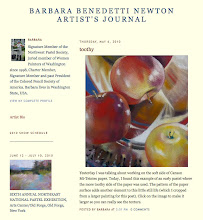A couple things today:
Double checking my painting
Discovery of Ruby Violet Light
Last night when I left the studio I was thinking "Studio Garden" was almost done. I liked it. This morning I took a photo of it and with Photoshop Elements, placed it next to the reference photo. Oh, oh. Not done. I used the pencil tool with red to mark areas to fix.
1. Shape of tree left side (add sky)
2. Bring the dip of the sky above greenhouse up higher so it doesn't point so obviously to greenhouse.
3. With a rigger brush, straighten some areas on top of the fence.
4. Important area in fence (square) needs grass.
5. Extend the flowering chives up on left to lead the eye to the center of interest (Rhodie)
6. Darken and finish painting upper right
7. Darker values in brick walkway
Comparing the art to the reference is fun. Every once in a while I think about offering this service to other artists. Sort of a Critique/Mentor/Advice role. Contact me if that interests you.
Vasari oil paint is wonderful! I have about a dozen tubes still in their felt-lined shipping boxes. Today while mixing color for the flowering chives, I wondered if I had a tube of anything to help me. Voila! Vasari Ruby Violet Light. Great color used alone and so useful to tone down other colors. Not too warm, not too cool. Love it!









































